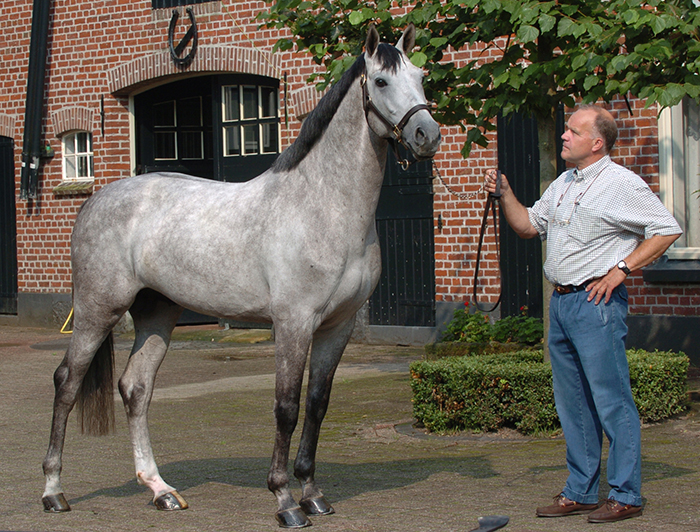
Jan Greve and his pride and joy, Tjungske. This young stallion is by the great Carthago, out of a mare by Dr Greve’s English thoroughbred stallion, Julio Mariner, who was in turn out of Kwiggy, who twice descends from Dr Greve’s foundation mare, Twiggy. Bred to Almé, Twiggy produced the stallion Dammen; bred to Voltaire, she produced Gwiggy – bred to each other, Dammen and Gwiggy produced Kwiggy, who bred to Julio, produced OK Wiggy, the dam of Tjungske.
There are few breeders more knowledgeable than Jan Greve, and there can be none better able to express their philosophy of breeding, or more generous with their time. It is hard to get the ultra-busy Dr Greve sitting in front of a tape-recorder, but once you do, and once he starts talking about breeding, then away you go!
Jan Greve is famous as a breeder of jumping horses – I guess everyone knows about his great stallion, Voltaire, but I was also interested to learn that he has also been a serious breeder of dressage horses… and that this interest goes back to one of the foundation mares of his famed Watermoelen Stud.
“It started 48 years before, with an old mare from the middle of the country, then we bred with her, a Lucky Boy and bred that filly to Amor and that started a dressage line. That was a very talented mare. I try not to mix the lines – dressage and jumping – I try to get to the strong point of a family and keep to it. If you have a good showjumper, don’t mix it with a dressage horse.”
But the feeling in Hanover now seems to be that you need a bit of jumping blood to stop the dressage horses getting too soft?
“I don’t think you need it, but I think you need to look at a good canter, especially how strong and correct they are behind in the canter, then it is no big deal to do the piaffe and the pirouette, they can take the weight on the hind leg – and that’s what the jumpers do. People have to be careful in the dressage world that they don’t just look at a nice head, and a nice trot, and lose the canter.”
But the horse you sent to the world young dressage horse championship was not the usual dressage bloodlines?
“That stallion, Scandic is something special, something new. Scandic comes from a very very good jumping family. There was a Lucky Boy mare who was very good, and she had a daughter by Acteur, but the lady who owned her made one mistake, she fell in love with the Takehner, Michelangelo and she bred her good showjumper to Michelangelo – and she bred a mare, Joline – a very modern high blooded type of mare, 170m big. I told her that I had been in Sweden, and that she should go to Amiral, he was a nice horse with a good character. She believed me, and we put in some frozen semen from Amiral and that produced the mother of my stallion.”
“I saw Solos Carex as a young horse in Denmark, he was an amazing young horse, and he is still competing internationally with Tina Wilhelmson.”
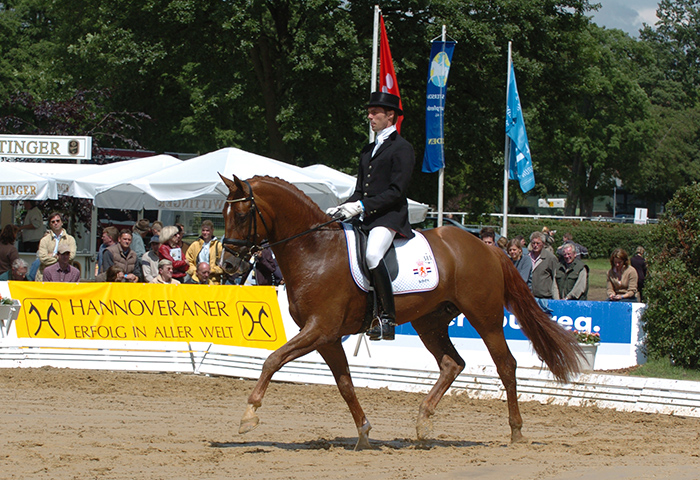
Scandic was a finalist at the 2004 World Young Horse Championships. He is a great example of Dr Greve’s breeding philosophy, and willingness to go ‘outisde the square’. His sire. Solos Carex in an international dressage competitor, but he is by a horse of classic jumping breeding: Castro by Cor de la Bryère out of a Landgraf mare. On his dam’s side, Scandic is related to Luidam (by Guidam) who was a finalist at the World Young Jumping Horse championships at Lanaken.
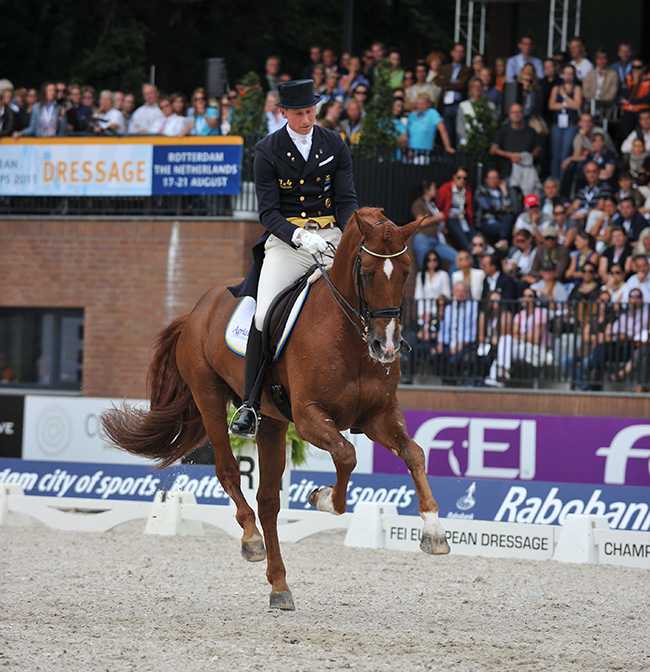
Scandic ridden by Patrik Kittel made their debut at international Grand Prix level in 2009. They were members of the Swedish team at the 2009 and 2011 European Championships, the 2012 Olympic Games in London and the 2010 and 2014 World Equestrian Games. Their career highlight was winning kur bronze at the 2011 European Championships in Rotterdam.
So you were trying to breed a dressage outcross?
“I didn’t breed him in name, but I am sort of the mental father. His first name was ‘shot in the dark’, because he was twice bred to stallions the mare owner had never seen, but we changed the name to Scandic because there is so much Scandinavian blood in him.”
But why did you go there for a dressage stallion, rather that the fashionable D, W, R, F lines in Germany?
“Because everyone does that. When I was a boy I hated going by the bus to school, everybody standing in the same line, I don’t like that, being too crowded. I wanted to breed something new.”
“For dressage horses, you need power behind, sometimes you need those strong mares behind, don’t look always to a nice front end and forget about the hind end, they did that for years.”
What has been the strength that Voltaire has given to jumping breeding?
“Good character, his progeny are very willing to do the job right. They are very sound horses. They are very strong in the back, and when you look at conformation, that strong back is very important for showjumpers, even though he is an old horse he hasn’t given up in the back. That’s what the Concordes have too, the strength in the back.”
What sort of mares does Voltaire work best with?
“Mares with a little bit of blood, and bold, very bold, strong characters – maybe too strong characters. Mares that might be too bold and not careful enough. Voltaire was very very careful, sometimes that is his weakest point. It’s very close the relationship between genius and the crazy one, and between ‘careful’ and ‘afraid’ there is just a little margin in there. Some Voltaires are too careful, too small hearted – that’s why a lot of them jump very tied up behind, when you freejump them. They are not bold enough to open up, they are very careful. You have to treat them right as a young horse, don’t take the heart out of them. That’s why Voltaire needs a mare that is very strong – Nimmerdor is a very good cross. A lot of Nimmerdors are very good as young horses, but when they get older, they are not careful enough, they are too full of themselves. Pilot works very well, Joost works well. Sometimes when you come back to the Le Mexico mares, but you have an in cross of the Furioso then.”
Has Concorde been the best son of Voltaire?
“Who can tell, he is the best we know of, there might have been better ones that we cut!”
Sadly for Jan, Voltaire’s death followed not long after the death of another fine jumping stallion, Julio Mariner.
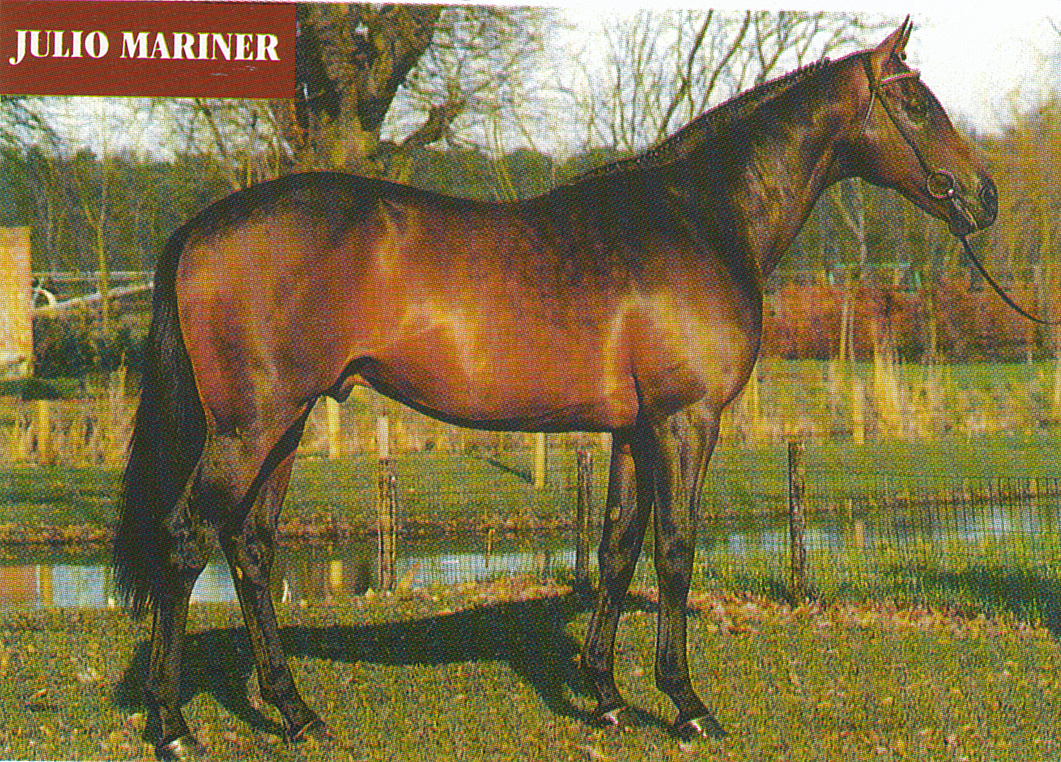
This horse, an English Thoroughbred, was a fine example of Bernard le Courtois’ observation, that sometimes a change of locale is vital in a stallion’s career. In his native Briton, Julio Mariner was a superstar on the track, winning the St Leger, but had limited success at stud before he was imported to Holland by Jan in 1988, when he soon set about carving himself a niche in jumping breeding history.
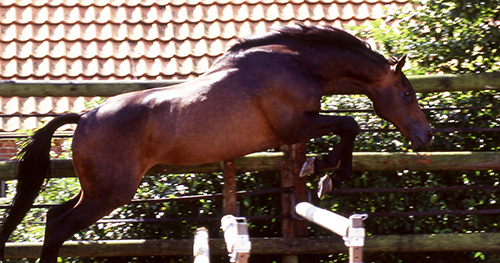
Looking at the career of Julio Mariner, what do you think he added to the breeding program?
“He produced extremely careful horses, and very quick from the ground, amazing quick reactions. And of course, when you breed to the Thoroughbreds, the main goal is to produce mares. You don’t use a Thoroughbred to produce good sport horses mainly it is to produce good half blood mares. The problem is that a lot of his mares are not too big, but the small ones are the better ones, 15.3 hh, 16 hh from Julio make excellent mares – but lots of people didn’t want to use them because they were too small. I have lots of Julio mares, and you can use them with a bigger stallion.”
Who is your next important stallion?
“I think Karandasj will do the job. He is competing internationally, and he comes from a very good family. He is by the Darco son, Fedor. The mother is a full sister to a good 1.40 horse we had, and the half sister to him is Kahlua who won a silver medal with Eric Lamaze at the Pan American Games. He makes very good quality horses, they are very willing to work for you – there was one sold to America for a lot of money, one won the four year old in Dublin last year, and the six year old class in Portugal. They are looked on as pleasure horses, very nice in the mind and they try to do the job right for you. Nice horses to work with.”
“In deals and deals, I lost Guidam, I sold him, something I should never have done, he was the best I had after Voltaire. I bought him as a two year old. I used a lot of French blood in the beginning, more than anyone else – but I don’t like the mouth, hard to ride, soundness problems. Stifles are very important and there you find a lot of problems with stifles, not all of them, but quite a few.”
And does the search go on for another good Thoroughbred stallion?
“Every day I am looking, every day. I have a horse called Painter’s Row by Royal Academy, he’ll breed some nice showjumpers. He was in Oldenburg for two years, then Holstein, then Italy and now we presented him again in Holland. We found nine of his progeny in Holland and free jumped them, amazing good jumpers – I think they misused him at first, thinking he should be a dressage stallion… nothing to do with dressage. I think from Holstein should come a few nice horses by him, they are three years old now. He breeds horses with very good reactions, very good technique. Then these idiots here rejected him because of their semen thing, say the semen is not good enough – in the lab. It’s so crazy so now he is in Denmark and they love him. We use him with frozen semen and the semen works very well. It’s just an idiot system they have here in Holland with the semen, they think they can predict in the lab, but there are so many factors in the fertility scene, that you cannot know, or we cannot find out, or it costs too much money to find it out. So we toss all these good horses away, a waste of good stallions.”
“You can only sell one thing – the showjumper who jumps the best, or the best dressage horse. That’s the only thing that sells – the main goal of breeding is the sporthorse. I have one mare, and everything she breeds has a chip either in the fetlock or in the stifle, or in the hock. Whatever. But they jump like hell, and make me so much money you can’t believe it! You have to take a chip out here and there, but they can jump. One is in Canada that had a chip in one hock, one in Ireland by Carthago had chips in both hocks but jumps unbelievable – so I don’t throw that mare away. It would be nice if the mare bred foals that did not have chips, but that is not the goal of the breeding – the goal is to breed good jumpers.”
OCD is heritable?
“Everything is heritable but it is a very difficult pattern of heritability, but for sure it is in the mare line. Some mares give it to all their foals. The problem with the stallion is that you cannot always see if the stallion will produce it. That’s why we are thinking of changing the system in Holland so it is not so strict on the stallions, but to look what he breeds – if there are 20 foals, do they have more OCD than the other ones? There are some ‘false negatives’ – stallions that don’t have it but spread it. There are others where it comes back, maybe in the third generation but not in the first.”
Would you knowingly breed with a stallion that was an OCD carrier?
“It depends. If I have a very strong mare and there are a lot of other reasons to use the stallion, then I use him. We have a few here in Holland that we know they give OCD, it’s not so nice, but some of them are good. There is one dressage stallion, 5 out of 10 have it, and the sons by him, also have it, but they are very nice horses. You don’t throw them away because they make OCD horses – it is a part of the breeding, you have to know it, but it’s not the main goal.”
Should the stallion owner be required to disclose to the mare owners if his stallion breeds OCD?
“In Holland we throw the stallions out, they are not allowed to breed. Every horse that is KWPN approved is OCD free, or it is not allowed to breed.”
So is OCD now less of a problem in Holland?
“We see it much less than in other countries. We have in Holland much sounder horses than everywhere else. I have 45 two year olds of my own, and I have been x-raying them to see where we should go, and what not to do, and with the German blood we always have something different. The ones that are not sound are nearly always the ones from a German mother – in Holland we have made very good progress on the soundness side, but we must be careful not to throw away too much of the rest.”
What is the goal in your jumping program?
“To breed international showjumping performers, to go to the top. It is very important to know your mare, that’s the most important thing. If I have a Julio mare, not so big but sound and very quick and reactive, then I am looking not for a Thoroughbred – I’m looking for a heavy horse, and maybe one that is not careful enough – that doesn’t matter because the Julio mother will give them carefulness for sure. But if I have a heavy mare that is very strong and very powerful, but a bit slow, then I am looking for a different stallion. Always try to improve what is lacking, don’t double up, don’t breed a big bully to a big bully. Try to find a good match up.”
If you breed a well bred jumping mare to a good jumping stallion, how sure can you be that you will get a jumper?
“Seventy percent. If you are very careful then you can do 70%, then it depends on little things, like the rider. It depends also on the mare lines, some mare lines are so strong. I have one old mare, the three quarter Thoroughbred mare, Twiggy, and Ovidius, the good sire in Holland now, is her grandson. Madison was a good jumper out of this mare. From the same family comes Baltimoor, that jumped internationally with Geir Guliksen. Now we have a Carthago son out of the same family. Nearly all of them jump – how good they are in the end depends on who gets them.”
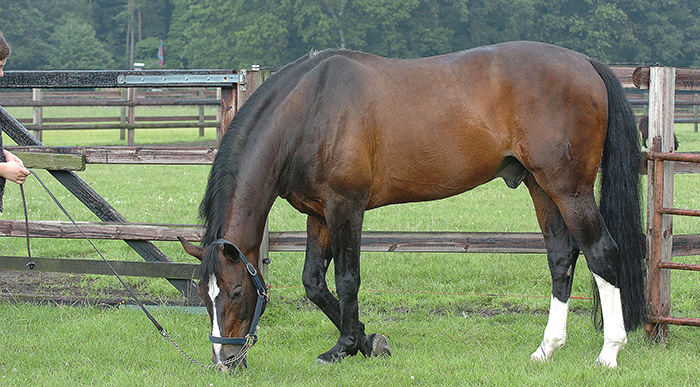
Voltaire: The Master on a walk takes a leisurely pick of grass just a few weeks before his death. Here was a stallion who was both an exceptional competitor in his own right (a winner of the Berlin Grand Prix) and an enormously influential sire, with just of 30 of his progeny appering on the World Breeding rankings. Before he died, Voltaire sired 40 stallions sons and countless broodmares. The individual silver medallist at Athens, Royal Kaliber is by Ramiro but out of a mare by Voltaire.
At Aachen in the Grand Prix of 2004, three of the four horses in the jump off were from the Holstein C – C cross. How important are those two C lines?
“It is the same philosophy that we were talking about before of not doubling up. Cor de la Bryère – extremely careful, they lack a bit of scope sometimes because they are not so good in the back. The other is the Capitol line, dumb power. No brain, just power, a lot of power. If you mix that, get a little bit of quality from Cor de la Bryère (by the Thoroughbred, Rantzau) and add to that the power, then you have the right mixture. You hope for the right mixture.”
“Sometimes we use that Capitol line, because we have quite a lot of blood, and we need power. For the Julio mares you need scope and power, all the quality is there, you just add scope.”
Do you think that showjumping breeding has developed so far that now we have a hundred very good jumping stallions so we will not have the great ‘hero’ stallions like Ramiro, or Almé or Gotthard in the future?
“There are more good ones than there were in the past for sure, and it is not so easy to be a star like Voltaire or Ramiro, because a lot of people are sending their mares to many different stallions, not just using one stallion. Ramiro he made some nice horses, but he also made some normal horses, very normal. But now there are so many stallions everywhere, that no one stallion gets enough mares to be the superstar. But among those ‘equal’ ones, there will be one in the end who will be the better stallion for sure. It is always the same family they come from, the dam line is so important, always look to the dam it is much more important than the father.”
If you could have any stallion in the world now – free gift – who would you take, Quidam?
“I used Quidam years ago when no-one heard of him. I bought Guidam out of his first crop. I heard that Quidam de Revel was jumping good, and he has got the most fantastic pedigree in the world, it’s all international or Olympic horses. So I looked for, and found, Guidam, who also proved to be a very good sire, I’m always looking for something new. Quidam de Revel is no longer a goal for me, everyone is using him. It was nice to breed to with him at the time when no one used him, too crowded on the bus. And I believe his son Guidam is better, if he gets the same mares as his father, he is better, more rideable, more elasticity, more power to collect. That is very important for the showjumper, to be able to collect your body, to make a stride on a metre and jump up – that is one of the most important things.
There are some nice young horses, Carry – a Holstein horse in Germany – he’s a nice horse.”
What about Darco?
“Darco is fantastic. You need a special mare, you don’t want to go with a big bully to Darco, you need some blood, with a strong back. It’s not so much looking around for stallions, I like to know my mare all year round and then find a stallion that will fit that mare. Aldatus, he is in Ireland now, he makes good horses, I think he will be very popular in a few years time.”
You are not only a breeder – you have a training barn?
“I have a dressage rider, he has about 10/15 horses, my son is now home, he was with Henk Hoorn for two years, and he is riding jumping horse, then we have a young man who rides the young horses. We have quite a lot of horses coming out every day.”
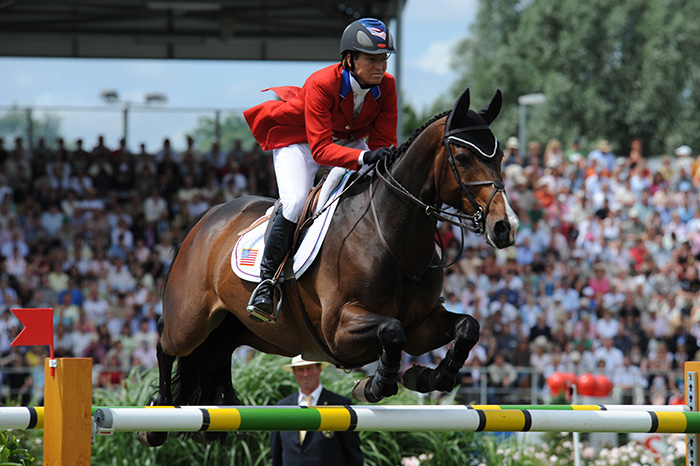
Beezie Madden and Authentic at Aachen
“I like to give every horse a chance, to see where they go to. I sold Authentic (Guidam) to Beezie Madden as a three year old, now I have the opportunity to hold onto horses longer and see where they go.”
“The problem with the modern breeding world is that there is too much fashion, everybody runs everywhere, and that means nobody arrives somewhere. They run from here to there. Five years ago I was talking to a breeder at a stallion show, and he said ‘it’s funny near me there is a man who always has good horses. In the past he only went to his next door neighbour, who is a stallion owner, and this man always had the best horses. Now he is running all around the world, ordering semen everywhere, but it is still the same breeder who has the best horses, the others can’t compete with him because their mares are not good enough. You can in-breed to a donkey if you want – but you still have a donkey. You need the power of a good mare. That is the part that people forget, you need the power of a family. If you don’t have much money you are better to buy not such a good mare from a good family than buy a good mare from a shit family – she will never breed, she doesn’t have the genes to breed. This mother was a very small Lucky Boy mare, 158 cm, I think she was a twin, she was born in the field but this little thing has bred unbelievable horses in dressage and showjumping. That’s a very strong mare. It is not always the individual that you look at – that’s a fault of the fashion world, they look too much for the special horse, they want a star mare or a kur mare. You need a good family, that’s the only thing that comes back.”
“From this strong old family there were Dutch champions as early as the 1950s, one side went to the dressage, one more to the jumping, but still the same strong family, with sound legs and a good mind. This is one of my main lines, and the second one is Twiggy. I bought her by luck. Her mother was by Koridon, who jumped 1.90 metres. She’s a good jumper herself, she’s a full sister to Best of Luck, who went to California. She bred Dammen, he’s a son of Almé, and a stallion in Sweden because of the semen thing. She bred with Creol, she is the grand-mother of Ovidius, a very good six year old stallion, she had one by Ahorn that jumped internationally – everything out of that mare line can jump.”
“I’m not sure why this happens but it seems to me that you cannot use the animal’s body twice – to have it a showjumper until it is 14/15 and then into the breeding, it hardly ever works. Ratina didn’t work. It might just be that it is too much to expect from the body. It’s funny but everybody has a certain age when you produce the best, with a milking cow, it is the third to the fifth calf that gives more milk. I cannot explain why it happens with horses but it does seem that you can’t use the body double, to be a good sporthorse and then to be a good mother.”
Everyone seems to have gone off using embryo transplants – once they were the big thing in Europe, now no-one very much is doing it?
“Because it cost a lot of money, and not enough comes out of it. It is not like a cow, with the horse it is very important in the first four or five months, which mare is next to the foal. They tried to use the cold blood mares – nothing – the cold blood mare just stands under the tree, and the foal just stands around too, and he is a dummy, he is ruined for life before he is one year old. We should have known it, because an orphan is a terrible animal, people treat orphan foals like dogs – bring them into the kitchen, oh he is so sweet – and they kill everybody. I have seen 3 or 4 like that in my practice and they were all shot, by the time they are three or four years old, they are dangerous, no education. That’s the trick with the mother, it is very important, who educates the foal. What they use now are Warmblood mares, maybe that is better.”
“What I used to do with the 3 year olds, is breed one or two foals, then try the mare as a sport horse. I don’t do that any more. Now I will have 10/15 three year olds, and I pick 2 or 3 that I like, and the free jump well, they go straight into the broodmare band, they don’t do anything else. Don’t try to do everything with them.. it doesn’t work.”
“With the Thoroughbreds, they did tests on thousands of foals, and the foals from the mare aged 6 to 10/11 were the best.”
And so it was time to leave, with warm thanks for Dr Greve’s valuable time, and a promise to meet again for another interview in the not too distant future – with breeders like Jan Greve there is always so much to learn.
UPDATE… 2010
We were lucky enough to catch up with Dr Greve at the 2010 KWPN Stallion Show in s’Hertogenbosch. He has just witnessed the rejection of his colt, Quidaro (by Quidam de Revel out of a Corrado I / Coriander / Schampus xx mare) by the licensing commission. I like many of the others at the show, was startled.
Your horse today looked beautiful…
“My horse, I think he is a phenomenon, I have had several good horses, but I think this is one of the better ones. He is very athletic, he has a very very loose body, you never get him in trouble. If they come close to a fence, I like a horse that can go out of the trouble because he is athletic, and he can do that. He is elastic, has a fantastic front and he is very intelligent, super canter. I thought I’d found a better Guidam. He looks a lot like Guidam but he is better I think, he is more loose and more supple.”
So what now? Another stud book?
“We may come back in August. We have another examination in front of the same judges, but under saddle.”
But his legs will still be the same shape…
“I don’t see anything wrong with the legs, not even as a vet, I don’t see anything wrong…”
Often for a jumper a slightly straight leg is a good thing?
“We need a hock that is low to the ground, then you have long thigh, with good muscle attachment to the hock, it’s like nature told us – you see a cat and you see a deer, and you see a different hind end, and the cat jumps better than the deer.”
Who do you see as the important stallions at the moment in Dutch jumping breeding?
“Of course we have Indoctro, which is very famous. Tangelo van de Zuuthoeve makes nice horses in the sport, Corland makes nice horses… Cantos is a young horse that is producing very well and seems to have very good sport horses.”
It is always still the same mix of the same basic blood – Cor de la Bryère, Landgraf, Ibrahim… nothing new…
“Nothing new, changes are not as quick in the horse world as we think. One year in the horse world is ten years, and in Holland we always have the mix, we don’t really have a breed, we have more the best selection program – it doesn’t matter if it comes from Australia or Norway, if it is good for our mares, we can take him. I think that is the strength of Dutch breeding, a very good selecting system, and not looking that it should be the same breed, like the Holsteiners do, we mix everything we can use.”
Do you think it makes sense to look at a jumping horse’s trot?
“It makes sense, but you have to have a different trot from a dressage horse, he should be bouncing from the ground and not so much extension as a dressage horse, a little bit of bounce from the ground. Basically, it doesn’t really matter, you don’t earn anything with the trot, you can judge the athleticism of the body when you see a young horse and how he trots.”
Looking at the relationship between conformation and jumping, the study in Hanover discovered a negative relationship between conformation and later jumping success…
“My own experience is that there are a lot of different types of horses that can jump. There are some basic things. They must have low hocks, and a long muscle there. They should be correct and sound horses, but the main secret is inside – it is the muscles and the suppleness of the body, and the strength of the body that makes a really good jumper, and the intelligence of the horse. It is much more related to the internal qualities, which we cannot measure, than the anatomy or the big or the small horse. You can have small horses with a powerful jump and a powerful canter that can do a great job, and you can have big horses with not enough scope. We look too much for the conformation I think in jumping, it is different for dressage.”
Do you ever look at the breeding values of a stallion?
“Breeding values mostly tell you what you knew already but then it is written down.”
UPDATE 2015 – and once again we meet at the stallion show
The view from the side line: Jan Greve
Jan Greve is one of Holland’s famous breeders (he is also famous as a vet) and as always his observations are worth listening to, he makes the point that the jumps and the distances are set up to test the horses, not to make them look fancy for the customers:
“The first day was a little bit disappointing, but on the second day, there were some very nice horses. Here in Holland, the KWPN doesn’t make a big sales show, we try to select horses that are athletic, that have brains, that can come back in the short distance, that can collect their body… it might not look so sellable but we try to find the best ones to breed with – not trying to sell a shit one.”
Haines by Carambole out of Stakkonita Z by Stakkato
Were there any stallions that really impressed you?
“I think my Carambole is a very nice horse. Van Uytert had a very nice one by Hors la Loi, the Arezzo from Wiepke van Lageweg was good, the Arezzos may not be the most elegant types, but they are good sport horses. The Arezzo/Indoctro should have been the champion. The Mr Blues are good, the Zirocco Blues – but they need blood on the mother’s side otherwise they are too stiff in the body.”
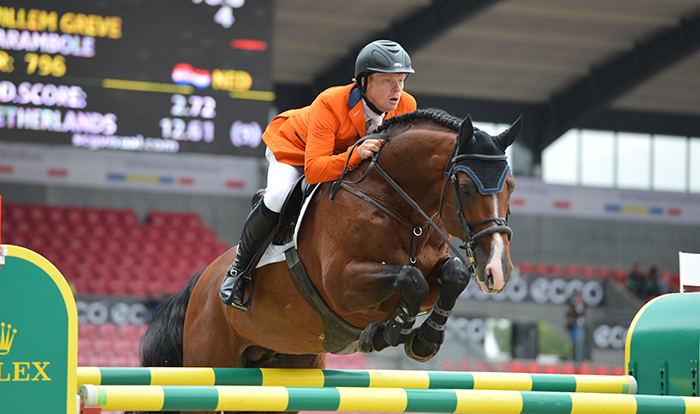
Willem Greve competing at the European Championships with Carambole
Dr Greve points to the way a community of breeders guides the future of breeding in The Netherlands…
“I think we are on the right way. It is controlled by everybody, a lot of people talk together. It is not the mind of one person, it is more the meeting of a lot of people, there is a lot of discussion in a positive way. We have an association of people who breed horses, bring on horses, show them here, we have the guys who buy the foals and bring them to the show, we have a group of dealers and the stallion owners, and two times a year we come together and talk about how we should do this, or that. Everybody can say what he thinks, then altogether you come to a point, a consensus.”


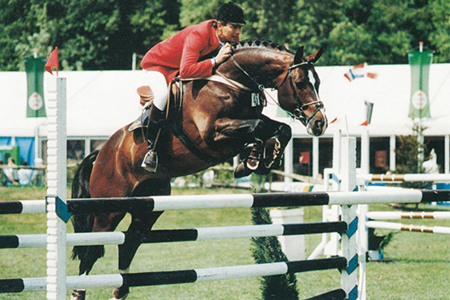
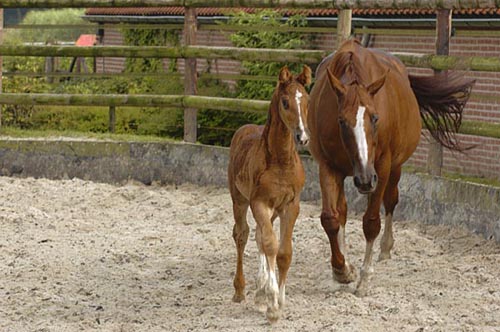
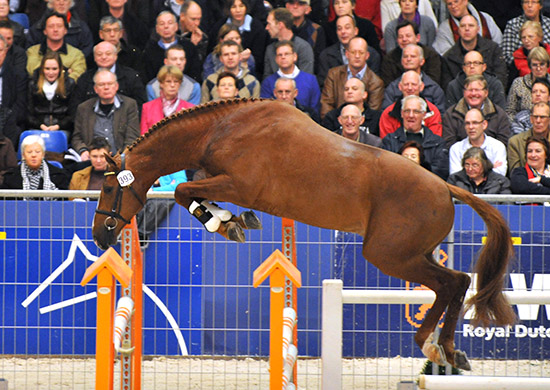
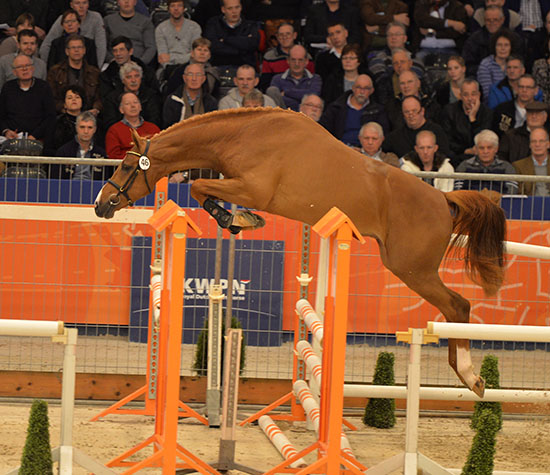
I have a nice big boned but light TB mare (by Silver Train ,AP Indy/Seattle Slew line and Reprised) and I am looking to find the right stallion for her. After reading the article that my FB friends forwarded I know the right person to ask, but how can I get my questions to Dr. Greve? In my gut I know what I am looking for but I do not know the stallion market in Europe and need some help. My goal is to breed international/Olympic level Show Jumpers
Excellent!
Superb article. We are breeding sport horses for seven years. Hopefully we can take a lot from the guidelines and ideas presented
Must say I agree 100% with Dr Greve’s thoughts on ET.
Enjoyed looking through this, very good stuff, regards . “To be positive To be mistaken at the top of one’s voice.” by Ambrose Bierce.
When Dr. Greve speaks of Best of Luck (Dutch name Octrooi) moving to California, I was the fortunate owner. Since then I have dedicated my life to the continuation of this great bloodline. There have been some very successful Hunters and Jumpers. January’s Best was the very top of the Hunters but that was before the internet and so much sharing of the successes. The horses have such good minds that they frequently are ridden by children and amateurs so they don’t always get a chance to prove their excellence. Right now Gee Whiz was the national Horse of the Year as a 6 Year Old Young Jumper and he is currently leading the standings to be the 7 Year Old Horse of the Year. But it is very hard to get people to understand the importance of the blood when they make their breeding choices. And then it is very expensive to raise and develop the young horses. I wish I could find a partner to help increase the continuation and impact of this excellent blood.